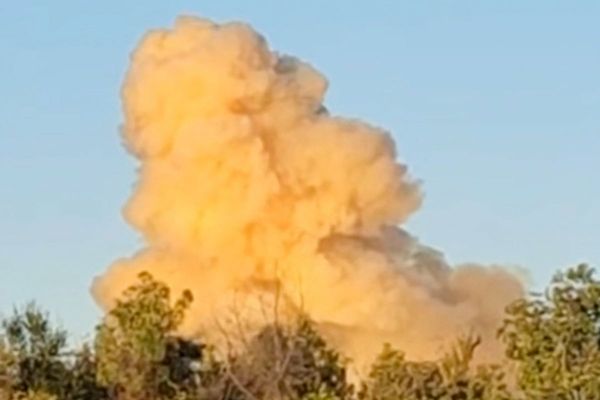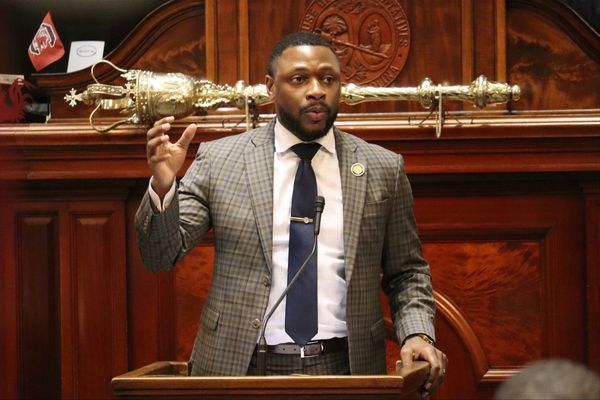
It is around midnight in Donbas, eastern Ukraine, and the first emergency ambulance of the night is charging 75mph down a single carriageway road from the frontline. Inside, under the care of two watchful medics, is Ihor, an unconscious soldier wounded from the battle of Chasiv Yar, with shrapnel, perhaps from a mine, in his abdomen.
The medics’ task is to complete the last leg of evacuation from the battlefield, which involves Ihor and tonight’s most serious casualties being taken to a hospital in the safe central city of Dnipro. Four ambulances are following on a bumpy high-speed run that takes three hours down roads largely deserted because of the 9pm curfew, the full single beds creaking and bouncing as they go.
“This is intensive care on wheels,” says Sergei Zakharchenko, one of the anaesthesiologists describing his night’s work inside a noisy but relatively spacious Mercedes Sprinter van. “It is a trauma of course, but it’s our work. You have to fight the war and you have to help people.”
One of the cases following is more serious still. Ruslan, operating in a smaller modified Toyota Land Cruiser SUV with just enough room for two people to work, is anxious. Their patient, whose temperature is rising, has a serious head injury and they believe shrapnel has entered his brain.
The crew know almost nothing about the casualty: they have no idea how he was injured or where he came from, and they have no name beyond the number 13 marked on his left hand, a method used by combat medics to aid subsequent identification. It is not uncommon to know so little – the reverse of the usual situation in a civilian hospital – such is the desperation of the war.
More than two years after the full-scale invasion began, the casualties from the frontline keep coming. In the case of the most serious who are taken to Dnipro, there are up to 50 every 24 hours. Ruslan and his crew speed off into the night, wanting to drive faster still. A casualty who gets this far has a high chance of survival, but in this case they are worried.
In their Mercedes, Zakharchenko and his medical partner Oleksandr Gres have to regularly attach new drips on the move, ensure the intubated patient remains sedated using Propofol, and at one point stop to check arterial pressure because the bumpy journey can make equipment readings unreliable.
The run to Dnipro is the final stage of the relay that takes the worst casualties from Ukraine’s Donbas front and is conducted by three-person crews working for the humanitarian organisation Moas, which was founded by Christopher Catrambone and began life by conducting migrant rescues off southern Italy, rescuing 40,000 people between 2014 and 2017.
Today, much of Moas’s work is in Ukraine, where it conducts about 80% of the last-leg critical battlefield evacuations in Donbas and 60% elsewhere. Its $1m (£800,000) a month operation is largely funded by private US foundations, because government agencies, such as USAid do not fund humanitarian work that could be considered linked to the military effort.
But it is not charitable work: Moas’s 150 employees are all Ukrainians paid local wages since it is not possible to build a consistent system with volunteers, particularly people from abroad who, even if they have helped out for a long time, will often want to leave at short notice.
Casualties are ferried from the battlefield by their fellow soldiers, first carried then somehow transported to a network of stabilisation points operating several miles from the frontline.
“We see every kind of injury,” says Oleksii Marchenko, a 42-year-old senior surgeon who works at a stabilisation point covering the frontlines near Bakhmut and to the north. “Even for me as a doctor, sometimes, I never saw things like this before.” The worst, he recalled, was a casualty “almost totally burned, 80% burned, even the airways”, who did not survive.
On the busiest day, when fighting in Bakhmut was at its height last year, his stabilisation point treated 220 casualties. “Sometimes you have to work click, click, click,” he says. Now, dozens are usually treated every night – sometimes rising above 100 – reflecting the fact that casualties from Chasiv Yar, the scene of the most intense fighting, are being treated at a different location.
The stabilisation points administer the most vital care before dispatching the patients as quickly as possible to a regional military hospital an hour or less along a mud road. Once treated, the “red patients” are picked up again by the Moas crews and taken to Dnipro in the ambulances; those with less serious injuries are put on a bus.
Shrapnel injuries are particularly common and one of the ambulance drivers, Oleg Andriiash, 52, estimates that 80% of the wounded are now the result of drone strikes, reflecting increasing Russian use of remotely piloted craft on the battlefield. “They keep launching drones at Ukrainian soldiers defending tree lines, 50, 100 drones, day after day,” he says.
A recurring problem is tourniquet syndrome, complications arising from a tourniquet being left on the patient far longer than the few hours typically advised. Amputations are more common as a result.
There are regular reports that evacuation vehicles are scarce, adding to the delays. It is also rarely possible to evacuate anybody by day because Russian drones may make out a group of Ukrainians congregating to lift somebody to safety, putting them at risk of being shot. By day the stabilisation centre is often quiet, allowing the medics some rest before night evacuations.
Morale among the medics remains high, and they appear relatively fresh despite the unrelenting work. But Andriiash worries that morale among the wounded is falling, particularly as military supplies from the US have dried up. “Recently, when you talk to people coming from the battlefield, it’s been difficult. The soldiers are in a difficult mood, because they don’t see the end of it.”







